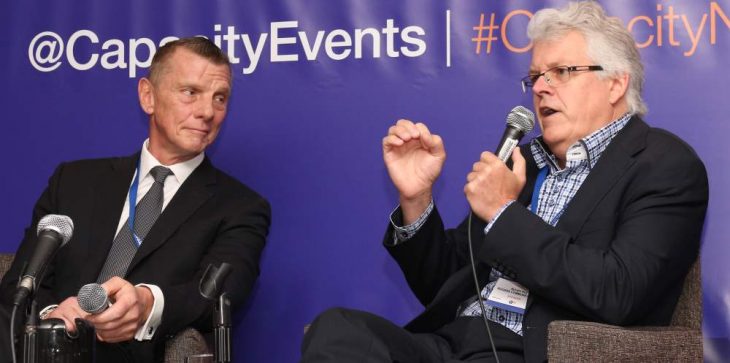
TORONTO – With millions of customers between them, you'd expect that customer service would be shining stars for Canada's biggest cablecos.
However, at a communications conference executives from Shaw Communications and Rogers Communications admitted they aren't there yet.
“I think we have a lot of work to do," Jim Pitt, vice-president enterprise, wholesale and tracking," said at a panel on leadership at the annual Capacity North America conference in Toronto. "I don’t think incumbents in general are well known for providing great customer service. We work very hard at it but we have work to do." Company surveys show that after price, service is important to customers and while call centres still do the heavy lifting, he added the company is "rapidly evolving" to deal with more customers through social media.
Fellow panellist Sylvain Roy (to the right of Pitt in the photo), who is Rogers Communications' president for Quebec and senior vice-president of wholesale and intercarrier relationships, said the same could be said for his company – for both retail and wholesale customers.
There's been a change of thinking recently at Rogers, he said. For example, "we've redesigned our web site and are trying to get people to do interactions on the site." The most recent revision on the site was to make it more friendly for consumers with smart phones, who prefer to access the Internet more with those devices than with PCs, he noted.
The exchange was part of a session that dealt mainly with how carriers are bringing innovation to their businesses. Innovation should be on every board's agenda, including telecom carriers, if they want to remain relevant, moderator Pascal Lamoureux, Deloitte Canada's national leader for telecommunications, asserted.
However, both Roy and Pitt said their companies aren't willing to be, as Roy put it, on the "bleeding edge."
Rogers has a long list of firsts, he added, including being the first wireless carrier in the country to bring HSPA and then the faster LTE service. "We're OK with being first in Canada – first in North America can work as well – but we're really trying aggressively to be first in Canada… It allows us to be leading edge without being bleeding edge, because being really first sometimes can sometimes be expensive. Let’s face it, our business is a scale business. We might be large in Canada but we're small from a global perspective."
"At Shaw when we think of innovation it's all about the customer experience… Then we try to create the value for which they’ll actually pay." – Jim Pitt, Shaw Communications
Similarly, Shaw likes being “fast followers rather than being in the forefront," said Pitt. He agreed with a dictionary definition of innovation as the process of translating an idea or intention to create value for which customers will pay. "At Shaw when we think of innovation it's all about the customer experience" and what they're looking for. "Then we try to create the value for which they’ll actually pay."
When asked what the biggest drivers of innovation are in their companies, both executives said the size of their companies compared to international carriers dictates some realities. Roy said Rogers tends to partner — for example, it has a pact with Vodafone to take advantage of the international carrier's power when buying equipment.
That said, Rogers also has a group that tries to attract small startups looking to sell products and services either for customers or the carriers' network. The goal, he said, is "when someone thinks about Canada they think about Rogers first."
"To American companies we're saying 'If you want to go international, Canada is international with training wheels.” – Sylvain Roy, Rogers
"To American companies we're saying 'If you want to go international, Canada is international with training wheels, we're next to you, same language, and we'll make it easy for you, and it is minimal investment. To the rest of the world that wants to go to America we say 'Why would you want to go to the U.S.? It's a big risk, humungous investment. Why don’t you first try Canada, get the learnings and then you can expand.'"
Pitt notes Shaw also partners — sometimes with Rogers, as with the Showmi over the top video service — and also keeps abreast of industry trends through Cablelabs and Canada's CANARIE research network. It also makes acquisitions, such as last year's US$1.2 billion purchase of the Colorado-based ViaWest data centre network.
But, he added, "we're not going to be able to go to the Ciscos of the world and say 'We at Shaw think you should be doing X, because we believe it will be very successful.' That conversation would probably last about five minutes, and we'd be politely asked to leave."
Asked what the biggest obstacle to innovation their companies face, Roy said it's Rogers' small size relative to some IT giants. Rogers issues perhaps seven software releases a year, he said, while Facebook does two a day. "If you're one of the top graduates in programming or design, would you want to work for Rogers or for Google … It's a global market now, so we need to find the right partnerships and we need to be attractive to global players so they pick us versus one of our competitors in Canada."
On the other hand, Pitt said the obstacle can often be "fear in disrupting ourselves (but) there's a lot of examples of companies that did not disrupt themselves and are no longer here,” he said, naming Nortel as one example.
"The challenge is how do we maintain the businesses we have and bring that disruption to bring value to customers?" Outdated business and operational support (OSS/BSS) systems don’t help, he said. "We need to disrupt ourselves and to start doing it in a bit of a hurry."



